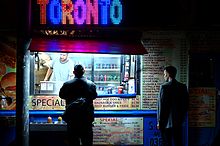Food swamp

A food swamp is an urban environment with few grocery stores but several non-nutritious food options such as corner stores or fast-food restaurants. One definition gives a general ratio of four unhealthy options for each healthy option.[1] The term was first coined by researchers conducting longitudinal studies of the link between increased access to grocery stores and rising obesity rates.[2] Rose and colleagues in this study found that even with a new access to local grocery stores, the proportion of convenience stores and fast food to a single grocery store did not shift food choices nor obesity rates. This indicates that food swamps are separate from food deserts.
The concept is comparable to that of a food desert. Those in a food desert have poor local access to nutritious food sources; those in a food swamp have easy local access to non-nutritious food.[3] According to researchers, food swamps are better measures for obesity rates.[4] One of the factors that may better explain this phenomenon is the surrounding neighborhood of a food swamp; researchers found that a large portion of the community do not use public transportation as their primary commute. This means that food options are still severely limited, especially when the nearest convenience store, bodega, or fast food restaurant is at walking distance and consumes the least amount of time. Differential barriers of low-income communities are mentioned as important influences on food swamp characterization.[4]
Influence on human health[edit]
Food swamps have positive, statistically significant effects on adult obesity rates, especially in areas where a majority of residents do not have access to personal or public transportation, and have disproportionate health impact on low-income minorities.[4]This environment is found in areas with strong corporate or industrial influence and is becoming a global phenomenon.[5] Research suggests a positive correlation between obesity rates and the ratio of unhealthy to healthy food options.[1] This is a consequence of fast-food options available in food swamps containing a high number of calories but a lower number of nutrients.[4] Some data also suggests that young adults living in close proximity to fast-food restaurants demonstrated higher incidence of type 2 diabetes.[5]
Racial/ethnic and socioeconomic influence[edit]
Out of 12 conducted studies, the results of 10 provided evidence that in the US fast-food restaurants are more likely to be located in areas with higher concentrations of ethnic minorities than whites.[4] Racial-ethnic and low-income minorities were shown to more frequently reside near unhealthy fast-food retailers than others.[4] This suggests that racial-ethnic low-income minorities are more likely to experience the detrimental health effects of food swamps, which is supported by the fact that African Americans and Latinos have higher obesity rates than whites.[1]
Controversy of term[edit]
The term “food swamp” has endured some criticism on account of its referral to wetlands with a negative connotation.[5] Critics have raised the point that while swamps have positive influences on ecosystems such as by detoxifying water and supporting biodiversity, food swamps exclusively cause problems for human health and the environment.[5]
Proposed solutions[edit]
To eliminate food swamps, researchers have proposed introducing policies which limit the amount of fast-food establishments and incentivize the distribution of healthy food options in an area.[4]To resolve the issues caused by food swamps, researchers have suggested that local governments should introduce policies such as new zoning laws that limit the number of possible unhealthy food outlets and incentivize the presence of healthy food retailers.[4] Lowering obesity rates is not dependent on the elimination of fast-food options but rather a more equal rate of unhealthy to healthy food options.[4] The Food Trust is an American nonprofit group that works to eliminate food swamps by ensuring access to food that is affordable and nutritious as well as by supporting programs which encourage SNAP recipients to buy healthy food.[citation needed]
See also[edit]
References[edit]
- ^ a b c Khazan, Olga (2017-12-28). "Food Swamps Are the New Food Deserts". The Atlantic. Retrieved 2022-03-28.
- ^ Rose, Donald; Bodor, J. Nicholas; Rice, Janet C.; Swalm, Chris M.; Hutchinson, Paul L. (2011). "The Effects of Hurricane Katrina on Food Access Disparities in New Orleans". American Journal of Public Health. 101 (3): 482–484. doi:10.2105/ajph.2010.196659. ISSN 0090-0036. PMC 3036701. PMID 21233432.
- ^ Canada, Health (9 October 2013). "Measuring the Food Environment in Canada". www.canada.ca. Retrieved 1 July 2023.
- ^ a b c d e f g h i Cooksey-Stowers, Kristen; Schwartz, Marlene; Brownell, Kelly (2017-11-14). "Food Swamps Predict Obesity Rates Better Than Food Deserts in the United States". International Journal of Environmental Research and Public Health. 14 (11): 1366. doi:10.3390/ijerph14111366. ISSN 1660-4601. PMC 5708005. PMID 29135909.
- ^ a b c d Elton, Sarah (3 September 2018). "Please don't call it a food swamp". The Conversation. Retrieved 2022-03-28.
